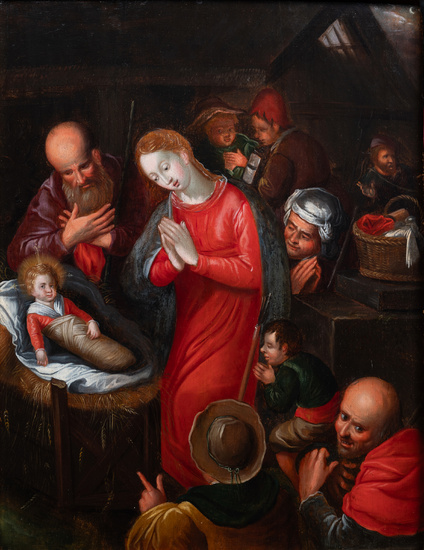Flemish school, 17th century.
Flemish school, XVII century.
"Adoration of the shepherds".
Oil on panel.
It presents restorations in the wood.
Measurements: 65 x 49,5 cm; 83 x 69 cm (frame).
The oil painting that we show belongs to the Golden Age of Flemish painting. It is a painting of the baroque period in which the Adoration of the shepherds is represented, a classic theme in the history of art. The Child Jesus, with his little body wrapped in a blanket, draws a diagonal on which converge the loving gazes of his parents and the praying shepherds. The nativity scene hardly receives any attention for the painter, only sketched by the spartan wooden walls and the skylight of the attic. Instead, priority is given to the individualized work of the characters, the careful modeling of each one of them. The Virgin stands out for her ivory skin, so clear and smooth that it seems to radiate light from within. In contrast, the male flesh tones are rosy, in the case of Joseph, and darker, in the case of the peasants. One of the shepherds turns to us and conveys an embarrassed expression. This contrast between the idealization of the Virgin and the veristic characterization of the popular characters was widely used in Flemish circles. The composition is asymmetrical and lively. It was characteristic of the Flemish tradition to treat biblical themes in a costumbrista key, which can be seen in this painting. Baroque painters, in general, sought above all a natural and close art. The only divine element that remains is the neonate's nimbus.
HELP
View it on
Estimate
Time
Auction House
Flemish school, XVII century.
"Adoration of the shepherds".
Oil on panel.
It presents restorations in the wood.
Measurements: 65 x 49,5 cm; 83 x 69 cm (frame).
The oil painting that we show belongs to the Golden Age of Flemish painting. It is a painting of the baroque period in which the Adoration of the shepherds is represented, a classic theme in the history of art. The Child Jesus, with his little body wrapped in a blanket, draws a diagonal on which converge the loving gazes of his parents and the praying shepherds. The nativity scene hardly receives any attention for the painter, only sketched by the spartan wooden walls and the skylight of the attic. Instead, priority is given to the individualized work of the characters, the careful modeling of each one of them. The Virgin stands out for her ivory skin, so clear and smooth that it seems to radiate light from within. In contrast, the male flesh tones are rosy, in the case of Joseph, and darker, in the case of the peasants. One of the shepherds turns to us and conveys an embarrassed expression. This contrast between the idealization of the Virgin and the veristic characterization of the popular characters was widely used in Flemish circles. The composition is asymmetrical and lively. It was characteristic of the Flemish tradition to treat biblical themes in a costumbrista key, which can be seen in this painting. Baroque painters, in general, sought above all a natural and close art. The only divine element that remains is the neonate's nimbus.
HELP



